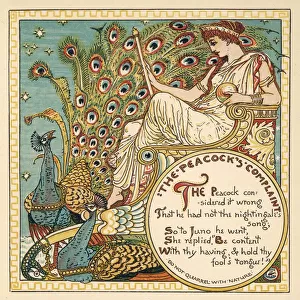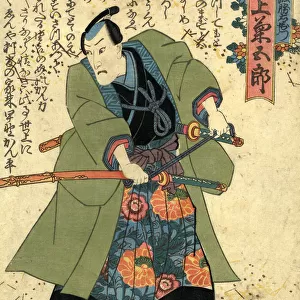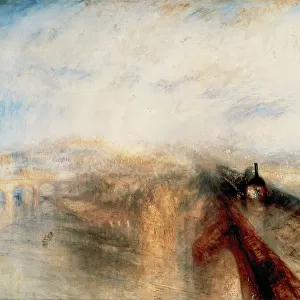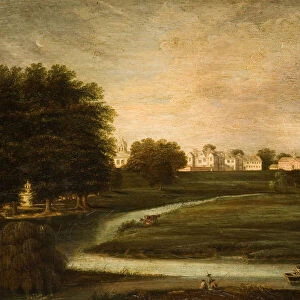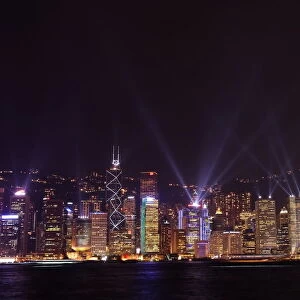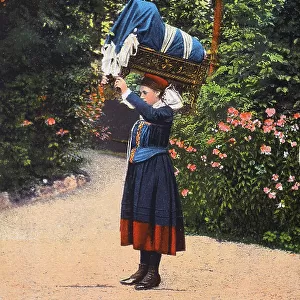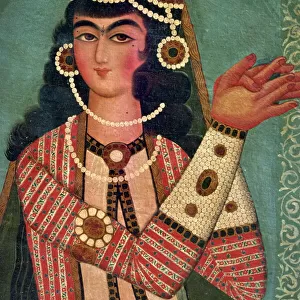Home > Animals > Birds > Peacock
Phoenixes and Paulownia, late 1500s. Creator: Tosa Mitsuyoshi (Japanese, 1539-1613), attributed to
![]()

Wall Art and Photo Gifts from Heritage Images
Phoenixes and Paulownia, late 1500s. Creator: Tosa Mitsuyoshi (Japanese, 1539-1613), attributed to
Phoenixes and Paulownia, late 1500s. The immense heraldic birds on display in these byobu reflect the Momoyama eras spirit of newly gained self-confidence and an affinity for grand expressive statements in painting, architecture, the textile and ceramic arts, as well as garden design. The setting is composed of highly stylized lozenges of mineral green paint, suggesting the earth from which clumps of grass, flowering plants, and towering bamboo and paulownia trees emerge. Clusters of lumpy, blue-green rocks dotted with lichen provide stabilizing three-dimensional foils for these islands of vegetation as well as the all-encompassing flat, golden surface. The glorious artificiality of the setting precisely serves the artists effort to compose a credible yet other-worldly vista for depicting the legendary phoenix gazing across the landscape at the pair of peacocks. Rather than an emblem of immortality, as it is in Western lore, in Japan the phoenix evolved out of its origins in Chinese mythology to become, by the sixteenth century, an auspicious symbol of political authority. A characteristic infusion of temporality has been included also, through a seasonal flowering schema extending from spring to early summer (right) to fall and the advent of winter (left). Although traditionally attributed to the Tosa school master Tosa Mitsuyoshi (1539-1613), these byobu possess neither seals nor signatures to confirm that authorship. Known for his jewel-like, modest-sized album paintings of courtly narratives such as The Tale of Genji, it is likely both studio training and contemporary fashions in patronage conspired to produce a good number of such byobu. This example from the Momoyama era represents one such effort from a masterful Tosa painter, too little seen in Western collections
Heritage Images features heritage image collections
Media ID 19648998
© Heritage Art/Heritage Images
FEATURES IN THESE COLLECTIONS
> Animals
> Mammals
> Cricetidae
> Golden Mouse
> Architecture
> Chinese
> Arts
> Art Movements
> Impressionism
> Arts
> Art Movements
> Landscapes
> Arts
> Artists
> J
> Japanese School Japanese School
> Arts
> Contemporary art
> Contemporary painting
> Landscape painting
> Arts
> Contemporary art
> Contemporary painting
> Arts
> Contemporary art
> Landscapes
> Arts
> Contemporary art
EDITORS COMMENTS
This print showcases the exquisite artwork titled "Phoenixes and Paulownia" created in the late 1500s by Tosa Mitsuyoshi, a renowned Japanese artist. The piece beautifully captures the essence of the Momoyama era, characterized by a newfound self-assurance and a penchant for grand artistic expressions. The focal point of this composition is undoubtedly the majestic phoenixes, symbolic creatures that evolved into auspicious symbols of political authority during this period. With an otherworldly gaze, they stand tall amidst a breathtaking landscape filled with towering bamboo and paulownia trees. The setting itself is meticulously crafted with stylized lozenges of mineral green paint, representing the earth from which vibrant grasses and blooming flowers emerge. To enhance its credibility while maintaining an ethereal quality, Mitsuyoshi incorporates lumpy blue-green rocks adorned with lichen as three-dimensional elements within this golden-hued vista. Additionally, he skillfully infuses temporality through a seasonal flowering schema spanning from spring to early summer on the right side to fall and winter on the left. Although traditionally attributed to Tosa Mitsuyoshi himself, these magnificent folding screens lack seals or signatures confirming his authorship. Nevertheless, their intricate details and masterful execution suggest that they are indeed products of his studio training and contemporary patronage trends. This exceptional example from the Momoyama era serves as testament to Tosa Mitsuyoshi's talent as both a courtly narrative painter known for jewel-like album paintings like "The Tale of Genji" and an accomplished creator of such rare folding screens that deserve greater recognition in Western collections.
MADE IN THE USA
Safe Shipping with 30 Day Money Back Guarantee
FREE PERSONALISATION*
We are proud to offer a range of customisation features including Personalised Captions, Color Filters and Picture Zoom Tools
SECURE PAYMENTS
We happily accept a wide range of payment options so you can pay for the things you need in the way that is most convenient for you
* Options may vary by product and licensing agreement. Zoomed Pictures can be adjusted in the Cart.



